A lot of people think being a prepper is all about stocking up on supplies. True enough, you can’t be very prepared without building up stockpiles of essentials – but that’s only half the battle. Once you’ve got it you need to store it, and that’s a lot more complicated than just piling it in your basement and forgetting about it until the fertilizer hits the cooling unit.
Preppers think a lot about food storage, which makes sense; food is essential, but it’s also perishable, so you need to make sure it’s stored well enough that, when you need it, it isn’t going to poison you. Water storage gets a lot of attention too, for the same reasons. There are some things that tend to get overlooked, though, and one of them is almost as important as food and water – ammunition.
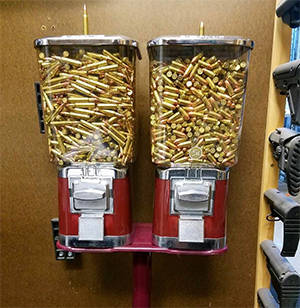
Ammo comes in a sealed box, and even if you store a bunch of loose cartridges in a paper bag they’re not going to visibly change much over time. The brass might discolor a bit, but this is ammunition, right? It isn’t like food; it doesn’t go moldy if you leave it on the counter too long.
Maybe not, but ammo still needs to be properly stored if you’re going to rely on it. Badly stored rounds might look fine, but they could be deteriorating inside and you won’t know a thing about it until you pull the trigger. Then you could find yourself with stoppages, bullets that don’t leave the barrel with a consistent velocity or trajectory – even dangerous hang fires or breech explosions.
Your ammo stockpile is there to let you harvest game and protect yourself. If you can’t rely on it, surviving through the crisis is going to be a whole lot harder – and if there’s civil unrest in your area, maybe impossible. Follow these tips to make sure you have a supply of ammunition you can rely on.
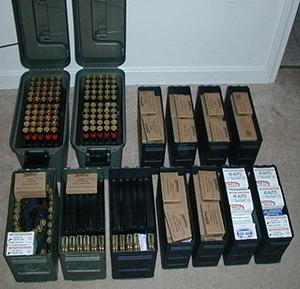 Start with quality ammo. There are places you can economise and save some money. Ammunition isn’t one of them. Keep bargain bullets and old military surplus for plinking; get the best ammo you can afford for your stockpile. A bargain price could indicate ammo that’s been on the shelves for a long time or hasn’t been properly stored. It could even have failed quality control. That isn’t usually a big issue, but in a survival situation can you afford misfires? Buy ammo that’s less than ten years old, and avoid damaged or torn boxes.
Start with quality ammo. There are places you can economise and save some money. Ammunition isn’t one of them. Keep bargain bullets and old military surplus for plinking; get the best ammo you can afford for your stockpile. A bargain price could indicate ammo that’s been on the shelves for a long time or hasn’t been properly stored. It could even have failed quality control. That isn’t usually a big issue, but in a survival situation can you afford misfires? Buy ammo that’s less than ten years old, and avoid damaged or torn boxes.- Rotate your supply. You already have a rotation system for your food supplies, and you should have one for your ammo too. When you buy ammunition pack it securely, label it with the date of purchase – and the date of manufacture, if you know it – and put it at the back of your ammo shelf. Take the oldest ammo from the front of the shelf and use that when you go to the range to practice. That way, when a crisis hits you can face it with your newest and most reliable ammunition in your weapons.
- Pack it protectively. Ammo – except some of that old military surplus you shouldn’t be adding to your stockpile – generally comes in a cardboard box. This is fine for most purposes, but it’s far from ideal for long-term storage. Cardboard doesn’t give a lot of protection from damp, which along with heat is one of the main enemies of stored ammunition.
- Can it. Military ammo cans with a rubber seal in the lid with give a lot more protection than a cardboard box. They’re moisture-resistant, rugged and easy to carry. If you’re storing boxed ammunition this is an ideal way to do it.
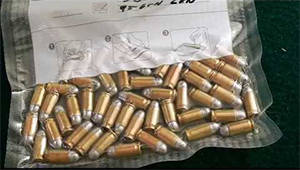 Vacuum pack it. The worst enemy of stored ammunition is moisture, and the main source of that is the air that surrounds it. The less air in the packaging, the less moisture can get at your ammo. If you can’t get military ammo cans you can protect ammunition by storing it in plastic bags and removing most of the air before sealing the bag. A vacuum cleaner is a good way to do this – it will remove most, but not all, the air. You might be tempted to go the whole hog and use a proper vacuum sealer to get all the air out, but this isn’t as good an idea as it seems. Cartridges are almost, but not completely, airtight. If you store them in a strong vacuum the air inside them will slowly bleed out until the pressure equalizes. When you open the packaging, new air will seep back in – carrying moisture with it. The chances of your survival refuge being drier than the factory where the ammunition was made are pretty low, so don’t tempt fate like this.
Vacuum pack it. The worst enemy of stored ammunition is moisture, and the main source of that is the air that surrounds it. The less air in the packaging, the less moisture can get at your ammo. If you can’t get military ammo cans you can protect ammunition by storing it in plastic bags and removing most of the air before sealing the bag. A vacuum cleaner is a good way to do this – it will remove most, but not all, the air. You might be tempted to go the whole hog and use a proper vacuum sealer to get all the air out, but this isn’t as good an idea as it seems. Cartridges are almost, but not completely, airtight. If you store them in a strong vacuum the air inside them will slowly bleed out until the pressure equalizes. When you open the packaging, new air will seep back in – carrying moisture with it. The chances of your survival refuge being drier than the factory where the ammunition was made are pretty low, so don’t tempt fate like this.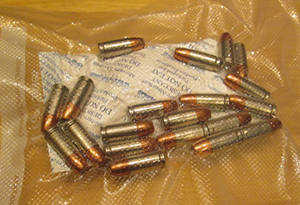 Use desiccants. Whatever kind of packaging you use for your ammo, throw some desiccant sachets in there to soak up any residual moisture that does make its way in. Bentonite clays work well – that’s what’s used in the popular Desi-Paks. Silica gel is also effective.
Use desiccants. Whatever kind of packaging you use for your ammo, throw some desiccant sachets in there to soak up any residual moisture that does make its way in. Bentonite clays work well – that’s what’s used in the popular Desi-Paks. Silica gel is also effective.- Keep it cool. Ammunition is designed to be as heat-resistant as possible – apart from the fact that guns get hot, it’s also designed to stay effective in a soldier’s ammunition pouches in desert conditions. Even if your ammo is civilian it still uses the same basic technologies as military ammo. However, it’s not foolproof. Hot storage won’t case short-term damage until you hit temperatures of well over 100°F (although a badly insulated store that gets direct sunlight can achieve that) but even moderate heat will degrade the performance of your ammo over months and years. Store it somewhere as cool as possible, while maintaining the focus on avoiding moisture.
- Check regularly. Don’t just trust your store to protect your ammo. Check it! If you find water leaking in, or temperatures rising for some reason, that will give you a chance to fix the problem before any real damage is done. If packaging is starting to show signs of damp or corrosion, you’ll know that the ammo inside can’t be relied on anymore and needs to be replaced.
In a survival situation it’s vital you know that, when you pull the trigger, the round in the chamber is going to fire reliably and send its bullet flying true to the target. The only way to guarantee that is to look after your ammunition properly. Follow these tips and your guns will be reliable, life-saving tools after the SHTF. Get it wrong and they’ll just be badly balanced clubs.
You may also like:
 How to Make Shotgun Shells at Home? (With Pictures)
How to Make Shotgun Shells at Home? (With Pictures)
If You Are Too Weak to Prep Then You Need to Watch This (Video)
Emergency Care For Gunshot Wounds

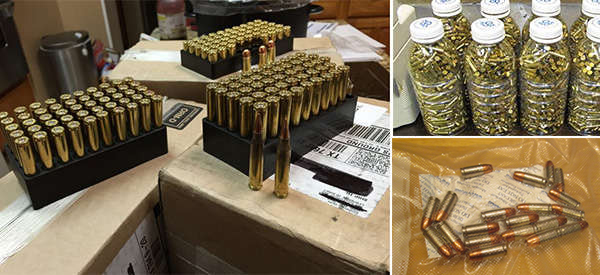
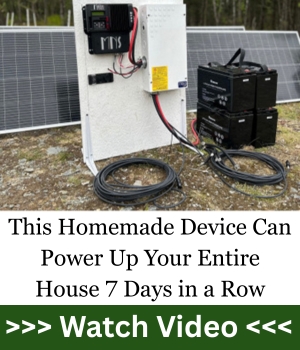


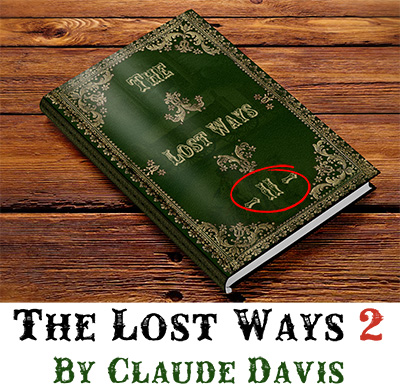
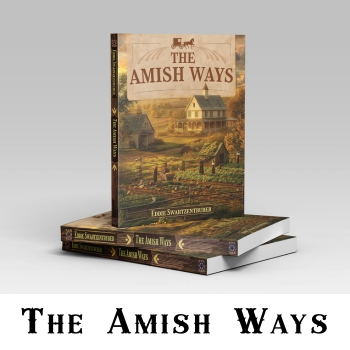








As you shoot your ammo and rotate it, pick up the cases and reload them. Thes are good suggestions for storing ammo. Layers of protection are a good idea. Have ammo in original packing, slip those into a ziplock bag then put them in Ammo cans. Would be a good idea to have one or two boxes of each caliber you shoot in individual containers you store end of world supplies in. Especially in bug out bags. If per chance you can’t gather all your things at least what you do grab has ammo in them.
I have a room that is temp controlled for my storage needs, I’ve got some ammo in there from the 90’s that still works fine, But it has been a while since I shot some so I guess I better go and check it out.
I have some ammo from 1968. Several years ago, I killed an Axis buck with one round. It has been in Spokane Wah, Anchorage Alaska, Wichita Falls Texas, Muenster Texas, Snyder Texas, and Kilgore Texas. Temps have ranged from -58 to 118 above 0. I’ll try to use up the rest this and next year.
I still think becoming a good archer is an even better survival skill for the long term than being a good marksman, even if you have plenty of guns and ammo stored up “against the day”.
1- Even if I lose almost everything I’ve stored up by having to run from where I am, for whatever reason, I can eventually make a functional if not ideal bow and some arrows from natural materials. I can’t make a gun, though, nor ammo for it. 2- Shooting an arrow makes a lot less noise than shooting a bullet. This could matter if someone’s chasing me but doesn’t know what direction I went, but now I need to do some hunting if I want to eat. 3- If an arrow splinters or otherwise malfunctions, it’s much less dangerous than if a gun misfires or jams. Important concern if medical assistance is minimal or non-existent.
But with that said, I’m not knocking gun ownership for preppers or any other sane adult non-criminals. Second Amendment, yeah!
Shouldn’t everyone own a firearm?
I would prefer that people convicted of violent crimes, whether or not they used a gun in said crimes, be disallowed from owning any firearm whatever. Same with folks relying on anti-psychotics and similar to prevent them from harming themselves and others. But non-violent, law-abiding people who want to defend themselves, their families and their homes from that first crowd, farmers who need to bust the groundhogs undermining their outbuildings, and legal hunters, why not? Nothing “deplorable” about that 🙂
Non violent? Violent people are the reason you sleep soundly at night.
Eh shall not infringe is clear. Serve your time and your citizenship should be restored.
i was convicted of the crime of posession of a pistol prior to 5 years from discharge of sentance. all crimes before that were non violent, but that crime is considered a VIOLENT CRIME. mere posession, no threats or intemidat aion required.
remember something is illegle only when you get caught. having your car windows tinted too dark is a crime, but only when a LEO uses a meter to measure the tint.
im an x ranger /green beret that takes lithium due to 6 years in combat why don’t you come take my guns
Lithium isn’t an antipsychotic! Neither is Panax or Prozac, if anyone here is taking either because of extreme anxiety about the future of our country. If they are, who can blame them?
You and your guns are safe, at least from me…and if I see anyone trying to break into your place, I’ll bag ’em with an arrow before you have to shoot ’em 🙂
(Might take me a few tries, though. I’m not that good…yet.)
The amount of special forces in prepping is always a fun time
The NRA is going to take guns away from you that’s for sure.
So if I sleep on a street in Chicago I will sleep safe because of all the violent people walking the streets?
I have yet to read the 2nd Amendment and find “except”, “unless” or any similar words after the word “infringed” in “SHALL NOT be infringed”.
Clue me in where any of “the people” are excluded.
been shooting a lot since 1958, tens of thousands of rounds including at air force base firing range…never had a explosion, problem beyond round not going off , or stuck extracting …minor , seconds to fix, clean , oil , fix or replace a 15 -20 year old part. If I NEED to feed my family I want to be able to kill a food source thats within range 400 yards, day or night, not in a tiny tiny little area where I hope something gets really really close and I get the right shot. Try downing a grouse, duck or goose in a fly by. If you rely only on archery you will starve as many in every indian tribe did every winter.
Having guns is very important for defense, but you should have different items that are not guns. Having a bow and arrow set is a good idea, however there might come a time when a different type of weapon is needed. A crossbow set is just one similar option. A slingshot with a standard size marble or steel ball is another. Sometimes you need to use a weapon that fits the situation. Protect your windows and doors. If you must home-defense, consider placing appropriately sized boulders into the ground to prevent Marauders from driving a vehicle into your home, to gain access. If SHTF then the only law available will be a gun, etc.
I double wrap cardboard cartridge storage boxes with plastic wrap, making sure to use big enough pieces that all ends are well overlapped. I use clear shipping tape to secure the plastic, again making sure that there are no openings where moisture can get in under the plastic. Then the plastic wrapped box is placed in metal cartridge boxes. and the boxes marked with the type of ammo and the date stored.
Harbor Freight sells 50 caliber new metal ammo boxes for $13.00 on sale. Except for occasional specials by Midway where they pay the shipping, that is the cheapest price that I have been able to find. Yes, the boxes are made in China, but they are indistinguishable from military surplus cans and in addition, the paint is new and there are no chips nor dents nor rust spots.
If you live in a very hot climate, you can then store the ammo cans in styrofoam ice chests which will level out the temperature extremes. They are surprisingly efficient.
BTW–the Army 50 cal cans (and others) with the rubber black seals should NEVER have these seals oiled or greased with petroleum products–that will cause the rubber in these seals to swell and become uneven, defeating the seal and air tightness.
USE: pure 100% silicone paste, like the 3M Silicone Paste, used in auto brake jobs or by electricians. It’s also called “Di-electric Grease.” Pricey–but what’s your ammo or life worth? Plus, any ammo you don’t use, your kids or grand-kids will thank you for!
https://images-na.ssl-images-amazon.com/images/I/81RinPOFzcL._SL1500_.jpg
Chuck, I get small plastic ammo cans from Wally World. They have rubber seal rings, hold 500 rounds of 5.56, a little less of 7.62X39 but are light enough to be easily carried. Here in Va. they are under $6.00. As much as I hate buying from Wally World I will still buy these boxes. Mike
are those ammo boxes at wally world in the sports or next to the trans clothing section. I would rather go broke then buy there, its all woke and Chinese communist products. Buy American
“You might be tempted to go the whole hog and use a proper vacuum sealer to get all the air out, but this isn’t as good an idea as it seems. Cartridges are almost, but not completely, airtight. If you store them in a strong vacuum the air inside them will slowly bleed out until the pressure equalizes. When you open the packaging, new air will seep back in – carrying moisture with it. The chances of your survival refuge being drier than the factory where the ammunition was made are pretty low, so don’t tempt fate like this.”
Properly loaded ammunition has the case mouths sealed to contain pressures that far exceed anything a home vacuum machine can produce. The bullet doesn’t start down its path toward the muzzle until the pressures in the case have built to the extent that the bullet is forced down a bore that is machined closely enough to contain up to 62,000 psi for the .308 Nato cartridge. That same pressure seals the mouth of the case against the walls of the chamber so that the shooter doesn’t get a face full of hot gases upon the bullet exiting the chamber and also to prevent the bolt from being forced back. If you have ever had a blown case, you know exactly what I am describing. That’s why not exceeding SAMMI specifications for pressure is so important and why examining your cases carefully when reloading is so important. A blown case inflict major damage on the firearm and injuries ranging form merely painful to death on the shooter and adjacent folk.
This bit of urban legend is similar to the poster who some time ago also recommended not vacuum sealing your ammunition as it would draw the bullets from the case during the vacuum sealing process. That bit of advise was totally fallacious. Anyone who has done reloading knows that getting a good case mouth grip on the bullet is a significant and important process in loading ammunition.
If your case mouth seal isn’t airtight, you are going to have varying velocities and erratic accuracy. A firm crimp is absolutely necessary to proper functioning of a semi-automatic firearm and necessary for accuracy in any firearm.
Lee Reloading dies have a factory crimp die, that you can purchase separately, I use them on my ammo and am very pleased with the results. They come for rifle and pistol and aren’t that expensive.
Eh stack deep store tight and be ready I shoot stuff from the 60s and 70s all the time.
I have M-1 carbine cartridges head stamped ’44 still in the original boxes that fire just fine. Will hit the bullseye at 100 yards if I do my part. They have not been reloaded. They are the original ammo. I got them with the gun when I bought it. My feeling is that they came from the CMP with the carbine back in the day when one could purchase a carbine for a very nominal sum. Who knows whose garage they have been stored in since the CMP sold the carbine.
I have fired some of them and they all went “bang” and made a hole in the target 100 yards away. They work the action of the carbine. Are they full power these many years later? I don’t know. I would have to chronograph new ammo against the ’44 stuff to be able to tell any difference. Would they knock a zombie down at 100 yards? Probably not, but then a brand new 110 grain fmj carbine round probably wouldn’t either.
I have some FN .303 150 grain ammo that is head stamped 55. It is still nice shooting ammo. It is Berdan primed but brass case and fmj with lead core. Shoots wonderfully. Has been in my garage in an ammo can since sometime in the 80s. Too bad Berdan primed is such a bear to reload.
Chuck, have you tried hydrolicing them out? Place butt of cartridge on a nut with a hole larger than the prime, fill cartridge about 1/2 full of H2O. Using a dowel in the mouth, pop it with a hammer. Should drive the primer out. I saw it done on youtube. Mike
Little known ammo storage fact of Little Bighorn, the battle of, The postbellum U.S.Army did not have the money for the troops to take target practice. Not only were they unfamiliar with their rifles the Gov was issuing copper cartridges and having the troops carry them in leather pouches allowing verdigris to form on the copper. Most of Custer’s troopers probably had the cartridge from their 1st shot hopelessly jammed in the chamber while hundreds of mounted Sioux and Cheyenne charged into their line.
Yeah, I learned about 55 years ago not to store brass cartridges in a leather cartridge belt. Turned the cartridges green, had a heck of a time getting them out of the loops and the belt was a mottled brown and green all around the loops. Took me hours with steel wool to salvage that ammo. Once was ’nuff. You can still see the dark marks around the loops where the verdigris was on the loops and belt. The ammo fired okay once cleaned up.
vacuum packing ammo for the long term storage purpose of a near airless environment is a waste of time >>> poly bagging is air penetrable – it’s for short term storage only ..
use mylar bagging if you want to go that route – pop in a 02 absorber and heat seal ….
“Ammo” about two years a gun dealer and collector showed me an antique pistol it had two barrels and he said that it was obsolete,it was in 32 cal and a rim fire cartridge well my Dad had this ammo which I ended up with, it was the cartridge for this pistol.
My father was 87 years when died,I got the ammo and we tried some they all work well ( the ones we tried) and they we black powder, copper cases and lead projectiles so I think if stored dry and cool ammo will last for a very long time.Note I have used .22 ammo that is over thirty years it works well.
Cheers,
Bob.
There are far more black powder firearms that are loaded with a charge just waiting for a cap to be put on the nipple and the firearm discharged than you can imagine. That was the way black powder firearms were stored. You put a charge in and hung it on the wall or behind the door and when you needed it all you had to do was put a cap on the nipple and you were good to go.
If you have a black powder firearm hanging over the mantle, check it. Run a cleaning rod down the bore and mark where the muzzle ends up when you hit bottom.. Pull the rod out and check it against the outside of the barrel.. Is the mark on the rod about an inch or so shorter than the barrel? Well, Pilgrim, that gun is loaded and probably will fire if ignited with a cap. You need a ramrod with a worm on it to pull the charge. Or you could just buy some caps and take it to the range and discharge it that way, but you would have to clean it afterward.
Civil War cannons in parks have sometimes been found in a loaded condition on occasion too. Nobody ever thinks that 150+ year old cannon is ready to fire. If the flash hole has been plugged, the powder is dry inside the bore because the ball that is waiting to be fired seals it from the muzzle end.